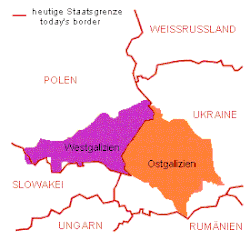Eastern Galicia
Eastern Galicia, or Eastern Halychyna (Ukrainian: Східна Галичина) is a geographical region in Western Ukraine (present day oblasts of Lviv, Ivano-Frankivsk and Ternopil) and Poland that has historic importance.[1] Galicia was formed within the Austrian Empire during the years 1772–1918. Eastern Galicia now includes all of the Lviv and Ivano-Frankivsk Oblasts (regions) of Ukraine as well as Ternopil Oblast, with its northern strip bordering the Raions of Kremenets, Shumsk and Lanivtsi and the northern part of Zbarazh Raion. The area of Eastern Galicia is about 46,800 km2 (18,100 sq miles).

History
In 1918, Western Galicia became a part of the restored Republic of Poland, which absorbed part of the Lemko region. The local Ukrainian population declared the independence of Eastern Galicia as the "West Ukrainian People's Republic". The predominantly-Polish population of Lviv (Lwów, Lemberg) resisted, which led to the Polish-Ukrainian War during which the Poles took control of all of Galicia. In a pact with Poland, Herman Petyura ceded Eastern Galicia in exchange for help against the Soviets. During the Polish–Soviet War (1919–1921), the Soviets tried to establish the puppet state, the Galician Soviet Socialist Republic, in East Galicia, but its government was removed in about two months.
The fate of Galicia was settled by the Peace of Riga, on March 18, 1921, which assigned Galicia to the Second Polish Republic. Although never accepted as legitimate by some Ukrainians, the decision was internationally recognized on May 15, 1923.[2]
The Ukrainians of the former Eastern Galicia and the neighbouring province of Volhynia made up about 12% of the population of the Second Polish Republic and were its largest minority. As the Polish government's policies were unfriendly towards minorities, tensions between the Polish government and the Ukrainian population grew, which eventually gave the rise to the militant underground Organization of Ukrainian Nationalists.
Etymology
The name "Gallic" or "Halchyna" in Ukrainian is derived from the city of Halych (Latin name: Galic) which was the first capital of Galician principality. The name Galic itself derives from the Ukrainian word halka which means "crow", which is reflected by the crow at the center of its coat of arms.[1]
Many also believe that the name Halych - Galic (and from it Halychyna - Galizia) is derived from the Greek word ἅλς (hals), meaning "salt". The Byzantines and the Greeks had a strong influence on these lands and it was from the Greeks that Galicia and Kievan Rus' were converted to Christianity. In fact the Greek word for salt pit is "Alyki" (αλυκή), which makes a strong argument that Halych could be an alteration of that. Halych was rich in salt, which was mined in the region. During the early medieval period, salt was Halych's main export.[1] Today, however, there is no more salt mining in Halych.
See also
References
Notes
- "History of Galicia". www.torugg.org. Retrieved 2015-09-29.
- Jean, Delorme (1956). Les Alliés reconnaissent à la Pologne la possession de la Galicie, Chronologie des civilisations. Paris.
Bibliography
- Encyclopedia of Ukraine
- Small Dictionary of History of Ukraine